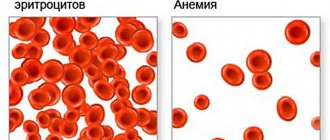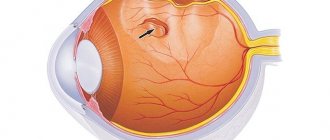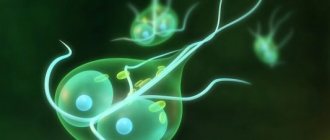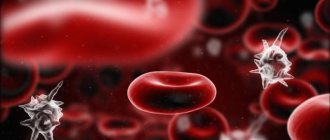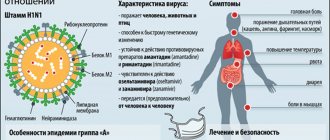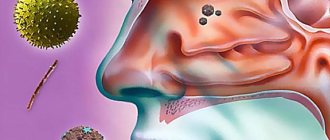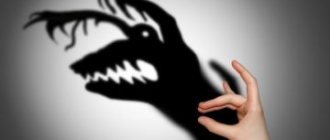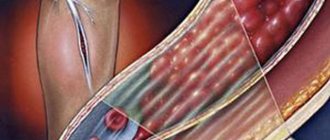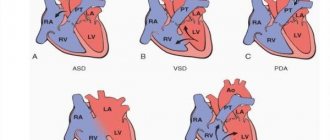Torticollis is a disease characterized by curvature of the cervical spine. In this case, the head tilts back, and the face is turned to the side and slightly upward. In most cases, the pathology is congenital, but can also affect people aged 35-50 years. In its mild form, torticollis brings discomfort to everyday life, head turns are limited, and a person cannot look around. In an advanced form, complex pathological changes occur in the tissues of the neck and skull. The skull is deformed, pronounced asymmetry is formed, and other concomitant pathologies begin to bother the person.
If treatment for torticollis is started in time, the disease can be eliminated. In this article you will learn the causes, symptoms and treatments for torticollis in adults.
Causes and types of torticollis in children
In medicine, it is customary to distinguish between congenital and acquired torticollis in children. Congenital torticollis is present in the child at the time of birth and most often in this case, a pathological course of pregnancy is detected in his mother:
- severe forms of toxicosis;
- oligohydramnios;
- risk of miscarriage.
Congenital torticollis in children can develop due to injury to the fetus, multiple pregnancies, or abnormal fetal position . Doctors do not rule out that the cause of congenital torticollis may be:
- disturbances in the birth process - for example, if a woman has a narrow pelvis, or there was weak labor and forced stimulation of the process, or the medical staff was forced to use obstetric instruments as obstetric aids;
- birth by cesarean section;
- birth trauma of the newborn.
The occurrence of acquired torticollis is possible at any age.
Preventive actions
In order to prevent the appearance or recurrence of torticollis, it is necessary to follow some rules. First of all, make sure that the child periodically changes his body position. To do this, you can rearrange the crib or simply approach it from different sides.
Try to force the child to keep his head straight . Attract him with bright toys.
The baby should sleep on a hard mattress. If he constantly turns over to the same side, put a soft cushion there that will limit the movement.
After being awake, the baby should be on his stomach. This way he can rest, his muscles will relax.
Following all recommendations will help prevent the onset of the disease. If you already have it, follow all the rules of treatment, and your baby will soon become healthy again.
Congenital/acquired muscular torticollis in children
This type of pathology is associated with a violation of the sternocleidomastoid (sternocleidomastoid) or trapezius muscle. There may be underdevelopment of the muscle, its ischemic contracture due to insufficient blood supply, shortening/scarring after tearing of muscle fibers. Most often, with congenital muscular torticollis in children, there is a combination of developmental defect and muscle injury during childbirth.
Please note: if muscular torticollis is acquired, then the causes of its occurrence may be acute/chronic myositis of the sternocleidomastoid muscle, sarcoma, myositis ossificans and Grisel's disease.
Treatment
Did you know that...
Next fact
As a rule, treatment for torticollis is complex . It includes massage, drug therapy, special exercises, as well as physiotherapeutic and manual techniques.
Drugs
One of the key components of complex therapy is drug treatment. For short-term relief of muscle spasms, botulinum toxin injections are used . They help return the head to its normal position for several months. The feasibility and possibility of using this drug are determined by a specialist individually for each patient.
For people with neurological diseases, they may be prescribed relaxants or antidepressants . The main task of such drugs is to block the ability of nerve impulses to pass through the muscles.
This allows you to straighten the position of the head and eliminate muscle spasms in the early stages of torticollis development. You cannot take antidepressants and relaxants on your own. They are available on prescription from a psychiatrist or neurologist.
Note! It is almost impossible to cure torticollis with medication alone. The pathological process occurs under the influence of several factors, which means that the treatment of pathology must be comprehensive.
Surgery
If a patient is diagnosed with an intervertebral hernia, the doctor prescribes surgery to remove it . The absence of surgical treatment in this case is fraught with the development of chronic pain syndrome, accompanied by spasms, increased muscle tone, etc.
Some patients have surgery to lengthen the muscle . They are carried out in several stages:
- the affected muscle is dissected;
- the muscle is lengthened.
This intervention is performed under local anesthesia in cases where conservative therapy has been ineffective. After the operation, recovery begins, which can continue for several months.
Exercise therapy and massage
Often patients with torticollis are prescribed massage . It helps normalize blood circulation and improve muscle tone in the affected areas. The doctor’s task is to send the patient for massage sessions at the right time (during an exacerbation of the disease, such an effect can increase the severity of painful sensations, especially in the presence of concomitant pathologies of a degenerative-dystrophic nature).
Note! If torticollis is accompanied by spasms of the neck muscles, a massage alone will not be enough to eliminate it. The fact is that initially the head changes its position due to a spasm of the sternocleidomastoid muscle, and over time other muscles are involved in this process. That is why the effect on the body in this pathology must be complex.
An effective procedure for the treatment of torticollis is electrophoresis using iodine preparations . These products have an antiseptic effect, reduce the risk of bacterial infections and have a relaxing effect on the muscles.
A special place in the treatment of torticollis is occupied by therapeutic exercises . Today, there are many tested exercise therapy programs (therapeutic physical education). The specialist’s task is to choose the program that is most suitable for a particular patient.
Gymnastics for torticollis helps restore the correct position of the head and improve muscle mobility. It is performed daily in the evening and morning.
Most programs include the following exercises:
- Head turns . The patient makes five or six turns of the head (first to one side, then to the other).
- Lateral muscle stretch . The patient lies on his healthy side, raises his head, holds it in this position for 3 to 5 seconds, lowers his head. The exercise should be repeated 6 to 8 times.
- Raising and lowering the head . The patient lies with his back on a flat surface, slowly raises his head and slowly throws it back. This leads to relaxation and stretching of the sternocleidomastoid muscles. The exercise is repeated 8 to 10 times. Patients with instability of the cervical vertebrae should take special care when performing it.
- Head tilts in different directions . The patient takes a “lying” or “sitting” position and begins to tilt his head to the left, then to the right, trying to touch his ear to the shoulder joint. The exercise is repeated 8 to 10 times.
Treatment at home or with folk remedies
At home, you can use medicinal herbs and plants. They will help relieve tension in the neck and calm you down. In the complex treatment of torticollis, the following recipes are used :
- Mix mint leaves, chamomile, motherwort, grains and nut shells in equal proportions. Add 2 tbsp. yarrow. Pour 200 g of boiling water over the resulting mixture and let it brew. Take 100 g before meals twice a day.
- Add mumiyo (0.33 g) and honey (1 tsp) to a glass of milk. Mix the ingredients. Drink in one gulp on an empty stomach.
- Eat juniper berries on an empty stomach. Every day, increase the portion by 1 berry until the number of berries reaches 12 pieces.
- Mix linden, lavender, berries and viburnum bark. Prepare a decoction at the rate of 1 tbsp. mixture per glass of water. To do this, pour water over the herbs, put on fire, bring to a boil and leave for 2 hours. Strain the broth and take 1/2 cup three times a day.
- Mix pork fat and lilac buds in a 5:1 ratio. Melt the ingredients in a water bath and let the mixture cool. Rub the resulting ointment into the shoulder and neck area four times a day.
Congenital/acquired osteogenic and arthrogenic torticollis in children
It is always a consequence of developmental disorders of the cervical spine - for example, it can be the fusion of the cervical vertebrae, or the fusion of additional vertebrae.
Separately, it is worth mentioning acquired torticollis of an osteogenic and arthrogenic type. This type of pathology can occur for the following reasons:
- fracture of the cervical vertebrae;
- tuberculosis;
- actinomycosis;
- destruction of the vertebrae due to osteomyelitis;
- tumor lesion of the vertebrae.
Diagnosis of spastic torticollis
To make a diagnosis, attention is paid to an unnatural (so-called dystonic) posture, corrective gestures and excessive movements, the presence of tremor, however, it may not exist. To exclude the hereditary nature of the disease, the patient may be prescribed genetic testing.
Sometimes a person does not even suspect that he has an illness. A simple test will help you suspect him: tilt your head first to one shoulder, then to the other. If you are healthy, your shoulders will not change their position. But if one of them rises, it means that torticollis may develop.
Congenital/acquired neurogenic torticollis in children
The causes of this type of pathology in question may be intrauterine hypoxia or infection in the fetus and muscular dystonia syndrome. If we are talking about acquired torticollis of a neurogenic nature, then its causes may be previous diseases - polio, tumors of the central nervous system, encephalitis, cerebral palsy.
Please note: against the background of diseases of the parotid glands, clavicle or mastoid process, reflex torticollis may develop. It is also called pain, it is short-term in nature and disappears immediately after completing a full course of therapy for the underlying disease.
Causes of pathological disorder
There are very specific causes of this pathology, among them:
- congenital underdevelopment of bone or muscle structures in the neck or their intrauterine damage due to chromosomal abnormalities, infectious diseases during pregnancy, improper positioning of the fetus in the uterus;
- injuries during passage through the birth canal;
- causes that arose after the birth of the child, such as improper care (which causes installation torticollis), trauma, infectious diseases;
- reasons that lead to the formation of torticollis in adults, such as diseases of the spine, neuroinfections, injuries, diseases of the nervous system.
Congenital/acquired dermo-desmogenic torticollis in children
This pathology occurs with pterygoid neck and Shereshevsky-Turner syndrome. In medicine, acquired dermodesmogenic torticollis is also diagnosed, which occurs due to extensive scarring of the skin, progression of phlegmon of the tissue of the neck.
Please note: doctors also differentiate compensatory torticollis, which is also called secondary. In children, it is associated either with pathologies of the organs of vision or with diseases of the organs of hearing. In some cases, torticollis can occur in absolutely healthy children - it will be called positional/positional, its development is associated with improper care of the baby: improperly laying the child down and carrying him in his arms with his head turned to one side, one-sided placement of toys.
Consequences of late treatment
If the problem is not identified in time and treatment is not started, the consequences of torticollis can be severe. Among them are:
- The appearance of severe facial asymmetry and cosmetic defects.
- Incorrect development of the skull.
- Deterioration of blood supply to the brain, which occurs as a result of excess pressure on the carotid artery. Because of this, severe headaches may appear and brain activity deteriorates.
- Constant tilting of the head can provoke deformation of the trachea. As a result, breathing becomes difficult and the incidence of respiratory diseases increases.
Only timely diagnosis and an integrated approach to treatment will help avoid such consequences.
Symptoms of torticollis in children
Read more…
If a child has an early form of congenital torticollis, then its signs will be noticeable immediately after birth, or in the first few days of the newborn’s life. If there is a late form of congenital pathology, then the clinical picture will maximally manifest itself at 2-3 weeks of the baby’s life. At the same time, a mild degree of congenital torticollis in children may not be recognized by parents and even a pediatrician for several months.
Typical clinical picture:
- When examining the baby, the doctor pays attention to the fixed tilt of the head to the shoulder and the turn of the chin in the opposite direction.
- If there is congenital muscular torticollis, then the child will have an enlarged sternocleidomastoid (sternocleidomastoid) muscle, and any attempts to force the baby’s head to a normal position cause pain and are accompanied by crying and protest from the baby.
- The child will have pronounced facial asymmetry, that is, the eye/brow and ear on the side of the head tilt will be located lower than on the opposite side.
- If bilateral torticollis is diagnosed, then the baby's head will be thrown back and brought to the sternum, and any movements of the neck will be sharply limited.
- In the case of the development of osteogenic torticollis, shortening and bending of the neck to one side, low head position and limited head movements in the cervical region are visually noted.
- If there is neurogenic torticollis, then both the parents and the pediatrician will immediately notice a high tone of the skeletal muscles on one side and a decrease on the other side of the neck, the baby’s hand on the affected side will be clenched into a fist, the leg will be bent. It is worth knowing that with neurogenic torticollis in children, all head movements remain normal.
Many parents are sure that the pathology in question will immediately manifest itself as facial asymmetry, but in fact this symptom appears only by the age of 5-6 years of the child’s life. And at this age the following will be noted:
Read more…
- underdevelopment of the auricle;
- flattening of the cheek on the affected side;
- improper jaw development;
- low location of the palpebral fissure.
It is very important to carry out diagnostic measures in a timely manner and begin treatment of the pathology in question. The fact is that in the absence of corrective procedures, a child may develop a whole range of complications:
- deformation of the skull, facial skeleton and spine;
- late eruption of baby teeth;
- asymmetrical crawling;
- poor balance;
- hallux valgus;
- scoliosis;
- delay in the development of sitting and walking skills;
- osteochondrosis.
In addition, a child with uncorrected torticollis will suffer from hearing and vision impairment, headaches, strabismus, and vegetative-vascular dystonia.
How to understand that a child has torticollis?
By the second or third week, parents may notice signs of pathology. Over time they become more and more obvious. But immediately after birth, it is difficult to determine the diagnosis even for experienced neonatologists.
Signs of torticollis in newborns:
- The baby can only tilt his head in one direction;
- It is difficult for the baby to suckle while in a certain position (when the head is tilted to the painful side). Often the child even refuses one of the breasts because he has difficulties during feeding;
- The shoulder blades are located at different levels;
- Most often, the baby throws his head back, it is tilted to the side (usually to the right);
- Parents can identify a lump by examining the neck with their fingers. The bean will be clearly felt on the affected muscle.
Not all parents know how to identify a disease in a child. When a baby has torticollis, most of the listed signs will prevail. If you notice the first symptoms, you should contact your pediatrician. The sooner treatment begins, the easier and faster the baby will get rid of the pathology.
Attention! More striking symptoms in newborns appear with acute torticollis.
Diagnostic measures
Read more…
If a child has a number of signs of torticollis, then pediatric specialists must be invited for consultation: a neurologist, an otolaryngologist, an ophthalmologist and an orthopedic traumatologist. When diagnosing torticollis in children, the following examinations are performed:
- comprehensive examination of the spine - ultrasound, computed tomography, radiography, magnetic resonance imaging;
- electroneurography;
- electomyography;
- Ultrasound examination of soft tissues and muscles of the neck.
The child must undergo an ultrasound examination of the hip joints and neurosonography - these diagnostic procedures will exclude or confirm the presence of concomitant pathologies with torticollis.
Diagnostics
To diagnose torticollis, you should make an appointment with an orthopedist, neurologist or surgeon. At the appointment, the doctor first palpates and examines the neck, checks muscle tone, head mobility, and assesses the presence of deformation in the bone tissues of the skull.
After the examination, hardware diagnostics of torticollis may be needed for a more detailed assessment of the disorder in the tissue structures.
Hardware diagnostic methods:
- X-ray. One of the simplest and most accessible ways to diagnose torticollis. Allows you to assess the presence of bone deformation in the neck and skull;
- MRI. The most detailed diagnostic method. Allows you to visualize the condition of not only bones, but also muscles, blood vessels and nerve fibers. MRI is painless and can be performed multiple times within a short period of time;
- Dopplerography of the vertebral arteries. Allows you to assess the condition of the walls and patency of arteries and vessels;
- electroneurography. Detailed examination of the condition of the nerve fibers of the head and neck.
The doctor can prescribe one or more hardware diagnostic methods to the patient, after which he can accurately determine the presence and degree of torticollis, as well as prescribe treatment.
Principles of treatment of torticollis in children
Treatment of the pathology in question should begin from the moment it is diagnosed. A very important role is played by stimulation of head turns (the child must follow the movement of toys), proper carrying of the newborn in his arms and the use of special therapeutic positions to give the correct position to the head.
Of course, the treatment regimen is selected on an individual basis, but there are also general principles for the treatment of torticollis in children:
- For muscular type of disease: courses of therapeutic physical education and massage, physiotherapy (in particular, UHF, paraffin applications and electrophoresis), therapeutic swimming. Experts may recommend that parents use a cervical brace, traction with a Glisson loop, or a Shants collar for their baby. If therapeutic measures do not give the desired effect, then at the age of one and a half to two years the child undergoes surgical correction of muscular torticollis - doctors perform a dissection or plastic lengthening of the sternocleidomastoid (sternocleidomastoid) muscle.
- Osteoarticular torticollis: step-by-step corrective immobilization of the cervical spine is carried out, taking into account the age of the baby and the severity of the development of the pathology in question. Such treatment is carried out using a plastic head holder, a Shants collar or a plaster thoracocranial cast. If it is not possible to correct a child’s subluxation, then doctors resort to spinal fusion of the cervical spine.
- With neurogenic torticollis, the patient is given drug therapy, which is aimed at reducing muscle tone and reducing the excitability of the nervous system. Simultaneously with pharmacotherapy, the child is prescribed general and/or local massage.
- Dermodesmogenic torticollis is not subject to therapeutic treatment. Only excision of scars and/or skin grafting will help restore the child’s health.
Symptoms and diagnostic methods
Torticollis can be recognized by the following signs::
- the presence of a club-shaped seal in the sternocleidomastoid muscle;
- severe spasms and pain that occur when tilting or turning the head;
- involuntary contractions of facial muscles;
- displacement of the head in the direction opposite to that on which the damaged muscle is located.
The specialist’s task is to listen to the patient’s complaints and conduct a visual examination.
The list of laboratory and instrumental diagnostic methods may include:
- MRI;
- electromyography;
- radiography;
- rheoencephalography.
When the presence of pathology is confirmed, the doctor must determine the characteristics of the course of the disease and develop an individual treatment program.
Video: “Torticollis - what is it?”
Definition of pathology
Torticollis leads to a noticeable rotation and tilt of the baby’s head, which often provokes a forced position of the head and neck, as well as deformation of part of the skull (especially in the lower jaw).
Muscular torticollis can be congenital, as a malformation of muscle fibers, or occur due to disease.
In any case, the development of torticollis leads to a reduction in the length of the neck muscle, causing its deformation, turning the head, and tilting it to the side. As a result, the child's head is fixed in such an incorrect, vicious position until medical intervention is carried out.
Video: Torticollis in a child - causes, consequences, how to treat
Symptoms
It is impossible to determine torticollis in a baby immediately after birth. As a rule, its first signs appear only 2–3 weeks after birth. Moreover, the symptoms are mild in nature, and only an orthopedic doctor can detect them.
The first sign of pathology is thickening and compaction of the muscles in the middle or lower third of the cervical region. This symptom appears closer to 3 weeks and is detected by palpation.
Over time, the clinical manifestations of torticollis begin to increase. The muscles become denser; when pressed on them, the baby may wince or act up. If you try to turn the baby's head in the other direction, this may cause him to cry a lot, as he will experience pain.
Right- or left-sided torticollis subsequently causes a deviation of the head towards the affected side with a turn of the face towards the healthy muscle. In this position, the child’s head is fixed, and he cannot turn it on his own.
If treatment for torticollis is not carried out or is carried out incorrectly, the muscles begin to thicken even more and shorten, then they atrophy. After this, the formation of skull defects is observed. Its bone structures are smoothed out in the affected area, asymmetry develops, and the head takes on an incorrect anatomical position. In severe situations, the shoulder rises, the facial and brain regions are deformed, and the shape of the eyes changes. If you look at infants from the back, you can see pronounced scoliosis of the cervical spine, asymmetry of the skull in the ear area, and muscle deformation.
Osseous, transient, positional and other types of torticollis are dangerous conditions that can lead to physical defects. To prevent them, parents need to carefully monitor the condition and behavior of their baby. And to understand whether a child has torticollis, you need to know exactly the symptoms of the pathology in order to promptly seek help from a doctor.
And to put it briefly, how to determine torticollis in an infant, the following symptoms should be highlighted:
- the baby constantly tilts his head only in one direction, left or right;
- attempts to turn the head in the other direction remain unsuccessful and cause the child to cry;
- It is difficult for a baby to have a straight head position.
If parents closely monitor their baby, they can easily recognize this disease and seek advice from a specialist in time, avoiding negative consequences.
Classification of torticollis
Torticollis in an infant can be of two types:
- Congenital.
- Acquired.
By congenital we mean the formation of a disease as a result of intrauterine development. This may occur due to the mother’s incorrect lifestyle or incorrect positioning of the fetus (as a rule, most patients with this diagnosis had a breech presentation).
By acquired we mean the formation of an illness after childbirth or as a result of childbirth (receiving a birth injury).
In addition, torticollis is classified according to the nature of the lesion, including:
- muscular (occurs due to disturbances in the GCS muscle itself);
- compensatory (as a result of eye diseases or associated with hearing impairment);
- neurogenic or neurogenic (as a result of disorders in the central nervous system or peripheral nervous system);
- bone (associated with problems in the spine);
- reflex (associated with muscle spasms and contractions);
- atrogenic (dislocations or injuries of the spinal joints);
- dermatogenic (associated with the appearance of scars on the skin);
- hypoplastic (develops as a result of partial formation of the GCL muscle);
- secondary (develops against the background of a secondary disease).
It has been established that the disease develops on the right in 80% of cases, while torticollis occurs on the left in only 20% of sick children. Nevertheless, the left-sided type of the disease is no different from the right-sided one, either in classification or in treatment options.
In addition, the acute subtype of torticollis should be noted. If the usual form of the disease develops progressively, then its acute subtype occurs suddenly (spontaneously), causing pain in the cervical spine and forcing the child to tilt his head so that the pain symptom subsides.
As a rule, the acute nature of the disease occurs mainly in older (school-age) children, and they are mainly associated with disorders in the bone department.
In the classification of the disease, the so-called positional torticollis plays a special role. The positional or attitudinal type of illness is in no way connected with disorders in the bone, neurological or any other part of the human body; here the main role is played by the force of habit. That is, the baby gets used to constantly turning his head to the left, because the parents constantly approach him from only one side, the newborn spends most of his time in the crib, rarely walks, etc., as a result of which this disease develops. Treatment of installation torticollis differs from treatment of other types of disease.
Complications
If such a disease is not treated, the following consequences cannot be ruled out:
- late eruption of temporary teeth;
- delay in the development of simple skills - children begin to sit, crawl and walk later than their peers;
- flat feet;
- rachiocampsis;
- scoliosis and osteochondrosis;
- unilateral impairment or complete absence of hearing or vision;
- strabismus;
- increased intracranial pressure;
- amblyopia;
- VSD;
- chronic headaches;
- valgus deformity of the feet.
How to treat crooked neck in infants
Torticollis in a child can be treated using conservative and surgical methods. The choice of method depends on the cause of the pathology and the nature of the course.
- It is important to identify torticollis early;
- Treatment is prescribed depending on the cause and form of the disease;
- Effective therapy involves combined procedures;
- It takes several years to cure congenital forms.
According to statistics, if treatment is started no later than 3 months, in 65% of cases it is possible to cure infiltrative torticollis. In the dystrophic type, the success rate of therapeutic procedures is 81%.
Consolidation of the result lasts for at least 1 year. Treatment can be stopped only when the muscle on the affected side is slightly longer than the counterpart on the opposite side.
It is optimal if the hypercorrection is maintained until the child is 3 years old. Subsequently, the damaged muscle will be able to compete with the healthy one and grow fully.
In 20-40% of children, the use of conservative procedures does not bring results, so surgical treatment is prescribed. In infants, the operation can be performed after one year of age, but due to the complications and serious consequences, the intervention is usually performed after 3 years.
Physiotherapy
Physiotherapy for torticollis is quite effective. Treatment of the disease with thermal procedures is used to accelerate blood supply and improve fluid absorption in the infiltrative congenital form of the disease. To warm the cervical area, paraffin applications, heating pads, and sandbags are used.
Electrophoresis with iodine has a resolving effect and promotes the rapid disappearance of inflammatory foci in muscle tissue. It also inhibits the development of fibrosis.
Attention! UHF therapy cannot be used, as it promotes the growth of non-functional fibrous tissue at the site of muscle fiber damage.
Massage
With the help of massage, it is possible to cure acquired forms of pathology in newborns and infants. They cannot yet perform gymnastics on their own, so massage treatments are the preferred option for treating the disease.
Massage for a crooked neck should be carried out on the convex side in the projection of the sternocleidomastoid muscle. At first, be sure to carry out light stroking, as vigorous movements will promote muscle contraction. On the opposite side, it is advisable to massage the trapezius muscle, which is an antagonist of the sternocleidomastoid muscle, and will therefore help reduce head rotation.
Gymnastics
Independent corrective gymnastics is prescribed for older children. Before a child performs exercises, specialists conduct a training course that allows the child to be taught careful movements and synchronized performance of gymnastics. For infants, doctors recommend that parents do special exercises, which should be done 3 times a day if they are ill.
Children 4-5 years old with a crooked neck should be treated with corrective movements, attracting the baby's attention with light effects or sound. There are special devices located on the side of the affected muscles that help you turn your head correctly when doing exercises.
In severe cases, doctors prescribe plaster collars, bandages and styling.
Laying according to Kozlovsky
Laying according to Kozlovsky is used for children in the first months of life when it is impossible to independently perform corrective movements of the head. Sandbags are used to maintain the body in the correct position. Cotton and gauze pads are bandaged on both sides of the child's neck and armpits. For a 3-4 month old baby, special pillows with cardboard inserts have been created.
The disease can be cured using bandages with traction. The devices hold the child's head and prevent the legs of the sternocleidomastoid muscle from approaching each other. The inconvenience of this method lies in the occurrence of unpleasant sensations that children find difficult to tolerate.
Note! You should not intensively treat your child with massage. Statistics show that with frequent massaging, children become irritable and easily excitable. Against this background, rapid weight loss is observed. To eliminate the consequences, it is necessary to alternate massage procedures with electrophoresis.
What is torticollis?
Torticollis is a neck deformity that can be congenital or acquired. It is characterized by an asymmetrical position of the head. It ranks third among congenital diseases.
The most common form of torticollis is the muscular form, when the neck takes on an unnatural position and the head looks tilted to the side. According to ICD-10 (international classification of diseases), the diagnosis of torticollis has code M 43.6.
Consequences of the disease
Torticollis is a pathology that requires timely treatment. But even after the disease has been treated, a relapse may occur.
If you do not start the right therapy, you can have unpleasant painful consequences:
- Impaired respiratory function, which is affected by tracheal curvature.
- On the affected side, otitis and sinusitis and partial hearing loss are more often formed.
- Strabismus, a disorder of vision that cannot be corrected by glasses.
- Disorder in the functioning of the speech apparatus.
- Headaches in adults.
- Impaired functioning of the neck muscles.
- Deviation in the placement of the mouth, eyebrows, eyes.
Classification
Torticollis, depending on the cause, has many types, but the following types of disease are most common. Torticollis can be either right-sided or left-sided.
Spastic form of torticollis:
- Formed after frequent tension of the neck muscles.
- According to research, the main cause of this form of the disease is disruption of the functioning of certain parts of the brain.
- Incorrect muscle position is caused by tension. This may be accompanied by pain in the neck, head, and shoulder.
- Sometimes painful spasms may also occur.
Other forms of torticollis:
- Neurogenic form. Occurs after infection in utero or prolonged acid starvation of the fetus. It belongs to the acquired form and is often formed after a child has suffered from cerebral palsy, tumors of the nervous system, encephalitis, or poliomyelitis.
- The false form of torticollis often has the same symptoms as the normal one, the muscles are also tense. But unlike conventional forms, the cervical muscle does not have dystrophic changes, and the cause of the problem may be a disorder of the functions of the nervous system.
- The acquired form is formed due to the influence of inflammatory processes in the muscles, tuberculosis damage to the vertebrae of the neck, osteomyelitis or oncological processes of the cervical vertebrae. The cause may also be paralysis or paresis, diseases of the lacrimal glands, or the presence of areas with scars after burns or other injuries.
- A congenital form with which the child is already born. It can be triggered by deformations in the sternocleidomastoid muscle, abnormalities in the formation of the vertebrae of the neck, and a low level of elasticity of the skin.
Symptoms
In cases of early development of the disease, the presence of such a disorder can be noticed immediately after the birth of the child or in the first days of the baby’s life. The late form of torticollis formation is characterized by its manifestation at approximately 3 weeks of life in children. It is worth noting that a mild version of this disease can go unnoticed not only by parents, but also by a pediatrician for a fairly long period of time (several months).
Clinicians identify the following main symptoms of torticollis in children:
- constant tilting of the head to one side;
- deformation of facial muscles;
- curvature of the spine in the neck area;
- increase in the size of the sternocleidomastoid muscle;
- pain and persistent crying or screaming when turning the head;
- squeezing the hand into a fist and squeezing the leg on the affected side;
- thickening of the cheek and low placement of the palpebral fissure;
- underdevelopment of the auricle;
- irregular structure of the lower jaw.
Symptoms of torticollis in children
The above symptoms of torticollis, but only in cases of primary origin, are often supplemented by the following deviations:
- malocclusion;
- underdevelopment of the joints of the pelvic region;
- cleft lip or palate;
- excessively short frenulum of the tongue;
- plagiocephaly.
The lack of qualified assistance causes irreparable consequences.
Taping for torticollis
One of the most promising techniques for treating torticollis and musculoskeletal disorders. For the procedure, tape is used - a special tape, the application of which provokes the activity of a sensory reaction.
Taping can give the following results:
- Normalize muscle tone.
- Motor regulation.
- Increased motor capabilities.
- Reducing the amount of edema.
- Reducing pain in affected areas.
- Developing better endurance.
Prevention
What can parents do to prevent the disease? First of all, the expectant mother must treat her pregnancy responsibly and be examined in time to identify and treat hypoxia and intrauterine infections. After birth, it is important to encourage the baby to turn his head in different directions. To do this, do the following:
- Hang a bright border around the entire perimeter of the crib, and not just on one or two sides.
- If the crib is against the wall, it is advisable to change the baby’s position, since he has to monitor the world around him in one direction. If space allows, you can move the crib to the center of the room.
- It is important that the mattress for sleeping is hard, then the baby’s head will not fall through.
- Place toys on different sides of the child. When carrying your baby in your arms, make sure that he periodically turns his head. Make sure that your baby does not sleep on the same side.
- Place your baby on his tummy more often.
In 90% of cases, if detected early, torticollis is completely cured. In case of severe deviations, as well as in the acquired form of the disease in older children, after therapy the condition improves, but is not completely cured. Until the age of 18, a child with a history of torticollis is registered with an orthopedist. So, it is imperative to treat torticollis, and as early as possible.
